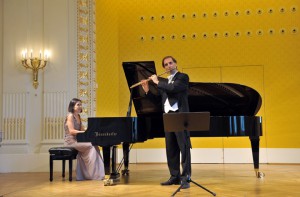In a concert sponsored by MidAmerica Productions, the Vienna Philharmonic’s Principal Flutist, Dieter Flury, was paired up with Bulgarian pianist Maria Prinz. It was a program dedicated to the 150th Anniversary of Debussy’s birth, and it contained two works written by the master: “Syrinx” for solo flute, and an arrangement of his “L’Apres Midi d’un Faune” by the Russian flutist and composer, Nikolay Ivanovich Platonov. “Syrinx” was given a beautifully shaped account; expressive and atmospheric. “L’Apres…” was given fine continuity of the work’s perfect architecture. The middle section, where the tempo is more driven and playful, was performed with more than a few missed notes in the piano part. Yet it was the music’s endearing serenity that made the lasting impression.
The Bach Sonata in B minor, BWV 1030, contained some lovely give-and-take of the musical line. In general, Flury played lightly, with horizontal phrasing that gave the music direction, and Prinz played more vertically, giving each note more equal attention. Balance was good; thankfully, the piano was on the short-stick, and one could hear all the flute lines throughout the entire concert. On many other occasions in this hall, I have heard the piano drown out the flute, so kudos to Prinz for her awareness to balance. Perhaps it was her cautious type of playing–a sensitivity to the flute’s vulnerability to the weight of the piano sound–that caused Prinz to play without much musical phrasing.
Prinz and Flury played perfectly together throughout the program, with excellent ensemble at all tempo changes. Flury has excellent rhythm and played with clarity throughout the program. His intonation is stellar as well, although at times, I wish his tone was more robust. Prokofiev’s masterful Sonata in D Major, Op. 94, received an excellent interpretation, one with smooth transitions, smart pacing and admirable cohesion of musical ideas. The classic scherzo had a wonderfully catchy tempo; unfortunately, Prinz had a difficult time with some of the passage-work in this movement.
In Milhaud’s Sonatina for Flute and Piano, there were lovely nuances of tempo, and the character of the music was infectiously playful. Enescu’s “Cantabile et Presto” from 1921 needed more dynamic range and contoured phrasing. It seemed that many passages within the forte dynamic started at a moderate sound and ended the same way. There were some nice subito pianos, but that wasn’t enough to always show the arch of the music.
In an encore, Faure’s “Fantasie”, Op. 79, Flury gave an outstanding virtuoso performance with a brilliant technical display. The second encore was Debussy’s “Le Petit Negre”, arranged from the original for solo piano. The work is somewhat jazzy for Debussy, but the piano playing did not swing on the syncopations; the short notes and the long notes had equal amounts of finger pressure, thus the beats and off-beat syncopations were heavy and sounded the same.
There was a full-house of flute enthusiasts in the hall; this was a worth-while celebration –not only of the flute–but of the master, Claude Debussy, who knew the instrument better than most.


